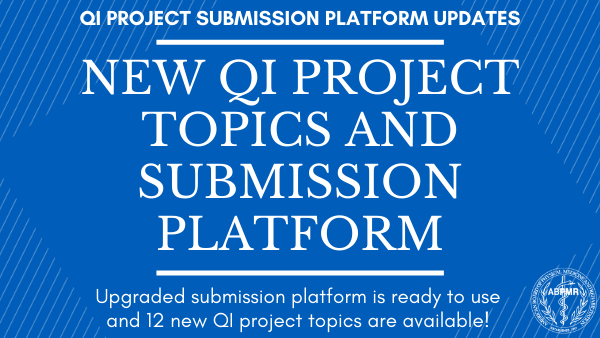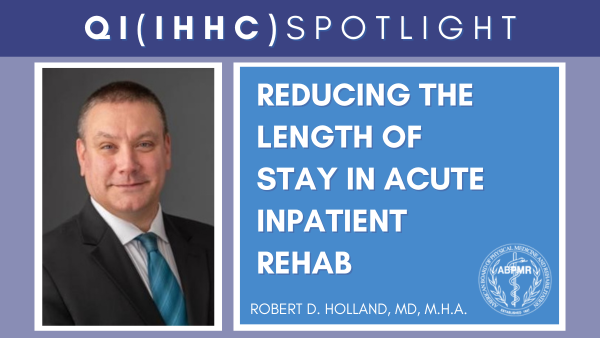CC
Just Launched: New QI Project Topics and Submission Platform

The ABPMR QI (Quality Improvement) project submission platform has been upgraded and is officially ready for all diplomates to use. In addition to a refreshed look and feel, the new platform provides a better user experience for diplomates and project reviewers. ABPMR Continuing Certification (CC) leaders have also shortened the form and number of questions asked, making the requirement less burdensome for diplomates.
Alongside the upgrade, the ABPMR has added 12 new Guided QI Projects, for a total of 20 free options from the ABPMR. These new topics address some of the most common issues in PM&R practice and are applicable to a broad range of practice settings. We hope the long list of options helps you identify a topic that will make a meaningful difference, adding value to your practice while fulfilling your CC requirements.
Below is the list of the new topics. As you consider possible topics for your QI project, see the topic summaries to find the topic that best fits with you and your practice. (Create your own project is also an option!)
Baclofen Pump Management:
Intrathecal baclofen pump complications may result in poor therapeutic effect, withdrawal, hospitalization, or reoperation. This project will walk you through the plan-do-study-act cycle to make an incremental improvement in baclofen pump management in your practice.
CAUTI Management:
Catheter associated urinary tract infections (CAUTIs) are one of the most common complications associated with hospital admission. CAUTIs can result in patient morbidity and mortality, extended hospital stays and increased health care costs. This project will walk you through the plan-do-study-act cycle to make an incremental improvement.
Department Wellness/Burnout Initiative (In collaboration with the AAP Chair Council):
Physician Burnout is a national problem due to the ever-changing face of health care: EMR burdens, decreased reimbursements, increased requirements and policing of documentation, insurance denials, loss of autonomy, etc. This project will help you apply the plan-do-study-act cycle to issues of physician burnout to help you make an incremental change to benefit physicians.
Diversity, Equity, and Inclusion:
Participation and contribution from diverse individuals are critical to the future of medicine and our civil society. A diverse workplace enhances creativity, problem-solving, and decision-making; increases productivity, employee engagement, and retention; and improves the reputation of the practice across the community. This project will help you apply the plan-do-study-act improvement cycle to areas such as staff and resident diversity, unconscious bias in payer and insurance considerations, holiday considerations, patient satisfaction measures, or your own idea for making a small improvement in this vital area. Improving Communication: Effective communication is important in almost every area of a physician’s professional work. Using the plan-do-study-act cycle, this project will help you apply quantifiable measures to what can feel like a fuzzy area.
Opioid Management:
Physicians considering prescribing opioids or renewing prescriptions for opioids may not be aware that patients are obtaining opioids from multiple providers or are being prescribed other substances that may increase risk of opioids (e.g., benzodiazepines) – both important safety concerns. This project will help you assess how often you're checking the PDMP and make a plan for improving.
Pediatric Fitness Surveillance:
The Physical Activity Guidelines for Americans suggests three hours of activity daily (a combination of light, moderate, and vigorous) in children ages 3 through 5, and at least 60 minutes of daily physical activity for children and adolescents ages 6 through 17. In addition, the prevalence of obesity has increased dramatically in school-aged children. This project will help you identify any gaps that exist in your consultations with patients, then use the plan-do-study-act framework to make an improvement.
Proper PPE Use:
Proper use of personal protective equipment (PPE) in health care settings has always been important for patient and provider safety, but PPE has gained increased attention in the era of COVID-19. This project will help you measure the current state, make a small change, and measure your results.
Reducing Falls:
Patient falls during an admission to an inpatient rehabilitation facility (IRF) or skilled nursing facility (SNF) can cause significant morbidity and possibly even mortality. This project will help you measure your existing state, set a goal, make a change, and measure your results.
Reducing Pressure Injuries:
Multiple factors (e.g. impaired cognition and/or sensation, decreased strength and mobility, poor nutritional status, incontinence, etc.) that are commonly present in patients admitted to an inpatient rehabilitation facility (IRF) or skilled nursing facility (SNF) can greatly increase the risk that those patients will develop pressure injuries. Prevention of pressure injuries is vitally important for these patients, as once pressure injuries develop, they can lead to significant morbidity. This project will help you define the problem, set a goal, make a change, and measure results.
Telemedicine:
Some practice areas were already starting to embrace telemedicine, but the COVID-19 pandemic substantially accelerated the widespread development and use of telemedicine. Although future regulations related to telehealth are uncertain, many physicians developed processes and procedures to care for their patients who were unable or unwilling to leave their homes. This project will help you identify a problem you'd like to address, determine your current state, make a change, and measure results.
The Single Event:
Medical errors are a common and serious problem in health care. The FDA receives more than 100,000 reports per year of medication errors. In a widely cited 2016 Johns Hopkins study published in The BMJ, medical errors were the third highest leading cause of death in the nation. A medical error is a single event that should prompt a root cause analysis in order to prevent a recurrence. This project will help you apply the plan-do-study-act framework to a single medical event, measure its impact, implement a change to prevent future errors, and determine the results of the change you made.

